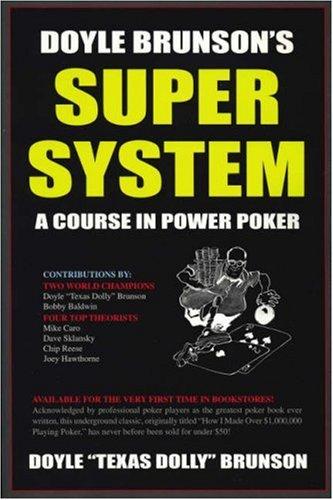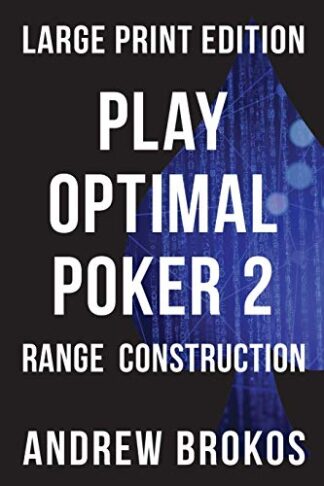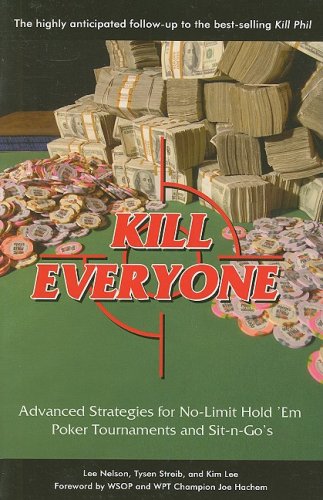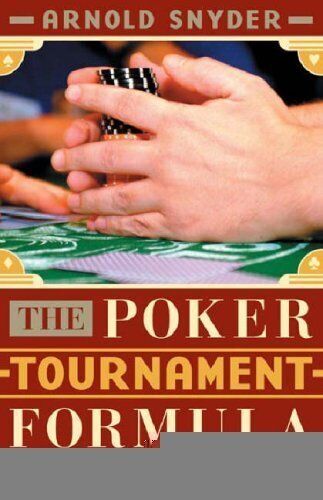Super System
Average price online: $18.00
Based on The Cover
In this comprehensive guide, two-time world champion Doyle Brunson collaborates with five leading experts to provide invaluable advice on when to raise, call, bet, and fold in various poker games. The book covers limit and no-limit hold ’em, high and low 7-stud, draw poker, and lowball. Brunson’s collaborators include poker legends David “Chip” Reese, Mike Caro, David Sklansky, Joey Hawthorne, and former world champion Bobby Baldwin, each bringing their unique specialties and insights to the table. This book is the result of over 10,000 hours of combined effort by the world’s greatest players and theorists. It stands unrivaled in its scope and value, offering a wealth of knowledge and strategies for serious poker players looking to elevate their game. Whether you’re a seasoned pro or an aspiring player, this book is an essential addition to your poker library, providing the tools and understanding needed to make informed decisions and improve your performance at the poker table.
A Review of the Book by ChicagoJoey
TL;DR - Important Takeaways
1. Play aggressively and be willing to gamble. Bet and raise frequently to put pressure on opponents.
2. Position is extremely important. Use late position to play more hands and bluff more often.
3. Small connecting cards (e.g. 7-6 suited) are very powerful hands that can win big pots. Play these hands aggressively.
4. Big pairs (AA, KK) should often be played slowly pre-flop to trap opponents.
5. AK is preferable to AA or KK because you can win more when you hit and lose less when you miss.
6. The flop is the most critical street for decision making. Most of the money often goes in on the flop.
7. Be very cautious with “trouble hands” like AQ, KQ, QJ offsuit. These hands can lose big pots.
8. In short-handed games, hand values go up and position becomes even more important.
9. Try to put opponents on a range of hands and play accordingly. Know your opponents’ tendencies.
10. Don’t be afraid to bluff, but have an “out” (some equity) when bluffing if possible.
11. Change gears and mix up your play to be unpredictable. Don’t fall into patterns.
12. Be willing to put your whole stack at risk with strong hands. Try to get all the money in when you have an edge.
13. Develop good hand reading skills and the ability to make tough laydowns when beat.
14. Have courage and the bankroll to handle swings. Don’t play scared money.
What We Learned From Reading the Book
1. The perspective that AK is preferable to AA or KK because you can potentially win more when you hit and lose less when you miss. This counterintuitive idea challenges conventional wisdom about hand strength.
2. The emphasis on small connecting cards (like 7-6 suited) as powerful hands that can win big pots. Many players undervalue these types of hands, so seeing them highlighted as favorites is enlightening.
3. The specific advice on playing different hand types through various betting rounds, with detailed examples of how to adjust based on the flop, turn, and river.
4. The concept of “trouble hands” like AQ, KQ, QJ offsuit, which can often lead to difficult situations and big losses. Identifying these specifically as hands to be cautious with is valuable.
5. The detailed discussion of how to adjust play in short-handed games, including how hand values change.
6. The nuanced approach to bluffing, particularly the idea of “bluffing with an out” – having some equity when bluffing rather than pure air.
7. The specific advice against taking insurance in most situations, with a clear explanation of the mathematical reasoning behind this.



